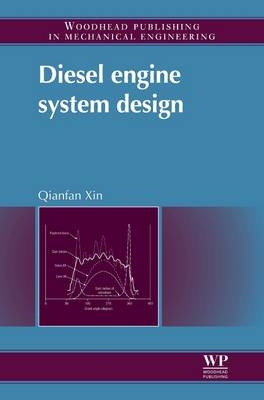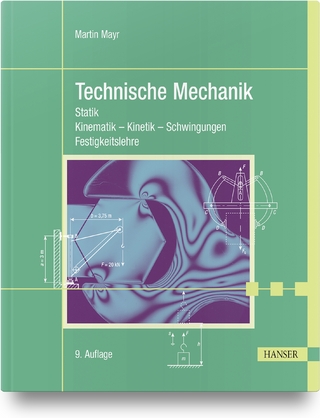
Diesel Engine System Design
Woodhead Publishing Ltd (Verlag)
978-0-08-101691-6 (ISBN)
Dr Qianfan Xin (also known as Harry Xin) obtained his DSc degree from Washington University in St Louis, USA. He has been working at Navistar, Inc. since 1999, and is a Product Manager in the area of advanced simulation analysis on diesel engine performance and system integration. He specializes in diesel engine system design and is noted for his work in this area.
Nomenclature
List of abbreviations and acronyms
Dedication
About the author
Preface
Part I: Fundamental concepts in diesel engine system design – analytical design process, durability, reliability, and optimization
Chapter 1: The analytical design process and diesel engine system design
Abstract:
1.1 Characteristics and challenges of automotive diesel engine design
1.2 The concept of systems engineering in diesel engine system design
1.3 The concepts of reliability and robust engineering in diesel engine system design
1.4 The concept of cost engineering in diesel engine system design
1.5 Competitive benchmarking analysis
1.6 Subsystem interaction and analytical engine system design process
1.7 Engine system design specifications
1.8 Work processes and organization of diesel engine system design
Chapter 2: Durability and reliability in diesel engine system design
Abstract:
2.1 Engine durability issues
2.2 System design of engine performance, loading, and durability
2.3 The relationship between durability and reliability
2.4 Engine durability testing
2.5 Accelerated durability and reliability testing
2.6 Engine component structural design and analysis
2.7 System durability analysis in engine system design
2.8 Fundamentals of thermo-mechanical failures
2.9 Diesel engine thermo-mechanical failures
2.10 Heavy-duty diesel engine cylinder liner cavitation
2.11 Diesel engine wear
2.12 Exhaust gas recirculation (EGR) cooler durability
2.13 Diesel engine system reliability
1 The components with high reliability importance can be assigned a high reliability since a high importance indicates the component has a large impact on the overall system reliability
Chapter 3: Optimization techniques in diesel engine system design
Abstract:
3.1 Overview of system optimization theory
3.2 Response surface methodology (RSM)
3.3 Advanced design of experiments (DoE) optimization in engine system design
3.4 Optimization of robust design for variability and reliability
Part II: Engine thermodynamic cycle and vehicle powertrain performance and emissions in diesel engine system design
Chapter 4: Fundamentals of dynamic and static diesel engine system designs
Abstract:
4.1 Introduction to diesel engine performance characteristics
4.2 Theoretical formulae of in-cylinder thermodynamic cycle process
4.3 Engine manifold filling dynamics and dynamic engine system design
4.4 Mathematical formulation of static engine system design
4.5 Steady-state model tuning in engine cycle simulation
Chapter 5: Engine–vehicle matching analysis in diesel powertrain system design
Abstract:
5.1 The theory of vehicle performance analysis
5.2 Engine–vehicle steady-state matching in engine firing operation
5.3 Powertrain/drivetrain dynamics and transient performance simulation
5.4 Optimization of engine–vehicle powertrain performance
5.5 Hybrid powertrain performance analysis
Chapter 6: Engine brake performance in diesel engine system design
Abstract:
6.1 Engine–vehicle powertrain matching in engine braking operation
6.2 Drivetrain retarders
6.3 Exhaust brake performance analysis
6.4 Compression-release engine brake performance analysis
Chapter 7: Combustion, emissions, and calibration for diesel engine system design
Abstract:
7.1 The process from power and emissions requirements to system design
7.2 Combustion and emissions development
7.3 Engine calibration optimization
7.4 Emissions modeling
Chapter 8: Diesel aftertreatment integration and matching
Abstract:
8.1 Overview of aftertreatment requirements on engine system design
8.2 Diesel particulate filter (DPF) regeneration requirements for engine system design
8.3 Analytical approach of engine–aftertreatment integration
Part III: Dynamics, friction, and noise, vibration and harshness (NVH) in diesel engine system design
Chapter 9: Advanced diesel valvetrain system design
Abstract:
9.1 Guidelines for valvetrain design
9.2 Effect of valve timing on engine performance
9.3 Valvetrain dynamic analysis
9.4 Cam profile design
9.5 Valve spring design
9.6 Analytical valvetrain system design and optimization
9.7 Variable valve actuation (VVA) engine performance
9.8 Variable valve actuation (VVA) for diesel homogeneous charge compression ignition (HCCI)
9.9 Cylinder deactivation performance
Chapter 10: Friction and lubrication in diesel engine system design
Abstract:
10.1 Objectives of engine friction analysis in system design
10.2 Overview of engine tribology fundamentals
10.3 Overall engine friction characteristics
10.4 Piston-assembly lubrication dynamics
10.5 Piston ring lubrication dynamics
10.6 Engine bearing lubrication dynamics
10.7 Valvetrain lubrication and friction
10.8 Engine friction models for system design
Chapter 11: Noise, vibration, and harshness (NVH) in diesel engine system design
Abstract:
11.1 Overview of noise, vibration, and harshness (NVH) fundamentals
11.2 Vehicle and powertrain noise, vibration, and harshness (NVH)
11.3 Diesel engine noise, vibration, and harshness (NVH)
11.4 Combustion noise
11.5 Piston slap noise and piston-assembly dynamics
11.6 Valvetrain noise
11.7 Geartrain noise
11.8 Cranktrain and engine block noises
11.9 Auxiliary noise
11.10 Aerodynamic noises
11.11 Engine brake noise
11.12 Diesel engine system design models of noise, vibration, and harshness (NVH)
Part IV: Heat rejection, air system, engine controls, and system integration in diesel engine system design
Chapter 12: Diesel engine heat rejection and cooling
Abstract:
12.1 Engine energy balance analysis
12.2 Engine miscellaneous energy losses
12.3 Characteristics of base engine coolant heat rejection
12.4 Cooling system design calculations
12.5 Engine warm-up analysis
12.6 Waste heat recovery and availability analysis
Chapter 13: Diesel engine air system design
Abstract:
13.1 Objectives of engine air system design
13.2 Overview of low-emissions design and air system requirements
13.3 Exhaust gas recirculation (EGR) system configurations
13.4 Turbocharger configurations and matching
13.5 Exhaust manifold design for turbocharged engines
13.6 The principle of pumping loss control for turbocharged exhaust gas recirculation (EGR) engines
13.7 Turbocompounding
13.8 Thermodynamic second law analysis of engine system
Chapter 14: Diesel engine system dynamics, transient performance, and electronic controls
Abstract:
14.1 Overview of diesel engine transient performance and controls
14.2 Turbocharged diesel engine transient performance
14.3 Mean-value models in model-based controls
14.4 Crank-angle-resolution real-time models in model-based controls
14.5 Air path model-based controls
14.6 Fuel path control and diesel engine governors
14.7 Torque-based controls
14.8 Powertrain dynamics and transient controls
14.9 Sensor dynamics and model-based virtual sensors
14.10 On-board diagnostics (OBD) and fault diagnostics
14.11 Engine controller design
14.12 Software-in-the-loop (SIL) and hardware-in-the-loop (HIL)
14.13 Cylinder-pressure-based controls
14.14 Homogeneous charge compression ignition (HCCI) controls
Chapter 15: Diesel engine system specification design and subsystem interaction
Abstract:
15.1 The process of system design analysis
15.2 Roadmap of fuel economy improvement
15.3 Critical mode design at various ambient conditions
15.4 Subsystem interaction and optimization
Chapter 16: Concluding remarks and outlook for diesel engine system design
Abstract:
Appendix: Statistics summary for probability analysis
Index
| Erscheinungsdatum | 07.07.2016 |
|---|---|
| Verlagsort | Cambridge |
| Sprache | englisch |
| Maße | 156 x 234 mm |
| Gewicht | 1490 g |
| Themenwelt | Naturwissenschaften ► Physik / Astronomie ► Mechanik |
| Technik ► Elektrotechnik / Energietechnik | |
| Technik ► Fahrzeugbau / Schiffbau | |
| Technik ► Maschinenbau | |
| ISBN-10 | 0-08-101691-3 / 0081016913 |
| ISBN-13 | 978-0-08-101691-6 / 9780081016916 |
| Zustand | Neuware |
| Haben Sie eine Frage zum Produkt? |
aus dem Bereich


